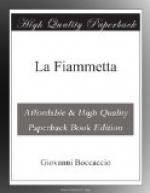INTRODUCTION
Youth, beauty, and love, wit, gayety and laughter, are the component parts of the delightful picture conjured up by the mere name of Giovanni Boccaccio, the prince of story-tellers for all generations of men. This creator of a real literary epoch was born in Paris, in 1313, (in the eleventh year of Dante’s exile), of an Italian father and a French-woman of good family. His father was a merchant of Florence, whither he returned with his son when the child was seven years old. The boy received some education, but was placed in a counting-house when he was only thirteen, and at seventeen he was sent by his father to Naples to enter another commercial establishment. But he disliked commerce, and finally persuaded his father to allow him to study law for two years at the University of Naples, during which period the lively and attractive youth made brisk use of his leisure time in that gay and romantic city, where he made his way into the highest circles of society, and unconsciously gleaned the material for the rich harvest of song and story that came with his later years. At this time he was present at the coronation of the poet Petrarch in the Capitol, and was fired with admiration for the second greatest poet of that day. He chose Petrarch for his model and guide, and in riper manhood became his most intimate friend.
By the time he was twenty-five, Boccaccio had fallen in love with the Lady Maria, a natural daughter of King Robert of Naples, who had caused her to be adopted as a member of the family of the Count d’Aquino, and to be married when very young to a Neapolitan nobleman. Boccaccio first saw her in the Church of San Lorenzo on the morning of Easter eve, in 1338, and their ensuing friendship was no secret to their world. For the entertainment of this youthful beauty he wrote his Filicopo, and the fair Maria is undoubtedly the heroine of several of his stories and poems. His father insisted upon his return to Florence in 1340, and after he had settled in that city he occupied himself seriously with literary work, producing, between the years 1343 and 1355, the Teseide (familiar to English readers as “The Knight’s Tale” in Chaucer, modernized by Dryden as “Palamon and Arcite"), Ameto, Amorosa Visione, La Fiammetta, Ninfale Fiesolona, and his most famous work, the Decameron, a collection of stories written, it is said, to amuse Queen Joanna of Naples and her court, during the period when one of the world’s greatest plagues swept over Europe in 1348. In these years he rose from the vivid but confused and exaggerated manner of Filocopo to the perfection of polished literary style. The Decameron fully revealed his genius, his ability to weave the tales of all lands and all ages into one harmonious whole; from the confused mass of legends of the Middle Ages, he evolved a world of human interest and dazzling beauty, fixed the kaleidoscopic picture of Italian society, and set it in the richest frame of romance.




